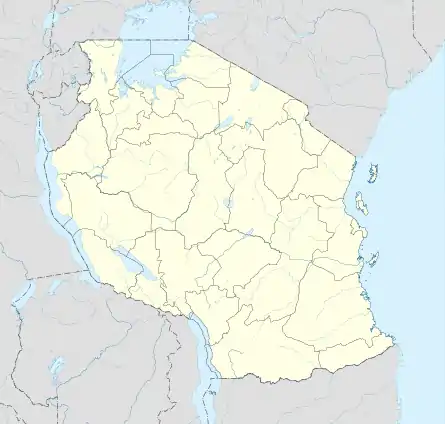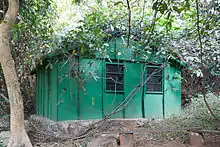Gombe Chimpanzee War
The Gombe Chimpanzee War was a violent conflict between two communities of chimpanzees in Gombe Stream National Park in Tanzania lasting from 1974 to 1978. The two groups were once unified in the Kasakela community. By 1974, researcher Jane Goodall noticed the community splintering.[1] Over a span of eight months, a large party of chimpanzees separated themselves into the southern area of Kasakela and were renamed the Kahama community. The separatists consisted of six adult males, three adult females and their young.[1] The Kasakela was left with eight adult males, twelve adult females and their young.
| Gombe Chimpanzee War | |||||||
|---|---|---|---|---|---|---|---|
| |||||||
| Belligerents | |||||||
| Kahama chimpanzees | Kasakela chimpanzees | ||||||
| Commanders and leaders | |||||||
|
Hugh † Charlie † | Figan | ||||||
| Casualties and losses | |||||||
| 10 chimpanzees | 1 chimpanzee | ||||||
 Location within Tanzania | |||||||
During the four-year conflict, all males of the Kahama community were killed, effectively disbanding the community. The victorious Kasakela then expanded into further territory but were later repelled by another community of chimpanzees.
Background
Prior to the four-year war, before it became a national park, Gombe National Park was known as the Gombe Stream Research Centre.[2] The park is located in the lower region of the Kakombe Valley,[3] and is known for its primate research opportunities first taken advantage of by researcher Jane Goodall, who served as the director of the Gombe Stream Research Centre.[2] The site itself is composed of steep slopes of open woodland, rising above stream valleys lush with riverine forest.[4] The chimpanzees roamed across these hills in territorial communities, which divided the chimps into parties ranging from one to 40 members.[4] The term Kasakela[2] refers to one of three areas of research in the central valley with the Kasakela in the north, the Kakombe, and the Mkenke to the south.[2] Evidence of territorialism was first documented once Goodall followed the chimpanzees in their feeding situations, noting their aggressive territorial behavior,[5] but she did not foresee the upcoming conflict.
After the separation of the Kasakela community, the newly formed Kahama were led by the brother duo Hugh and Charlie, with the other males being Godi, De, Goliath, and the young Sniff. The Kasakela males consisted of the alpha male Figan, Satan, Sherry, Evered, Rodolf, Jomeo, and Humphrey.
War
First blood was drawn by the Kasakela community on January 7, 1974,[6] when a party of six adult Kasakela males consisting of Humphrey, Figan, Jomeo, Sherry, Evered, and Rodolf ambushed the isolated Kahama male Godi while he was feeding on a tree.[7] This was the first time that any of the chimpanzees had been seen to deliberately kill a fellow male chimp.[6] After they had slain Godi, the victorious chimps celebrated boisterously, throwing and dragging branches with hoots and screams.
After Godi fell, De was taken out next, and then Hugh.[8] Later on came the elderly Goliath. Throughout the war, Goliath had been relatively friendly with the Kasakela neighbors when encounters occurred. However, his kindness was not reciprocated and he was killed.[9] Only three Kahama males remained: Charlie, Sniff, and Willy Wally, who was crippled from polio. Without a chance to strike back, Charlie was killed next.[10] After his death, Willy Wally disappeared and was never found. The last remaining Kahama male, the young Sniff, survived for over a year.[11] For some time it seemed as if he may escape into a new community or be welcomed back to the Kasakelas, but there was no such luck. Sniff, too, fell to the Kasakela war band.[12] Of the females from Kahama, one was killed, two went missing, and three were beaten and kidnapped by the Kasakela males.[13] The Kasakela then succeeded in taking over the Kahama's former territory.[13]
These territorial gains were not permanent, however. With the Kahama gone, the Kasakela territory now butted up directly against the territory of another chimpanzee community, called the Kalande.[14] Cowed by the superior strength and numbers of the Kalande, as well as a few violent skirmishes along their border, the Kasakela quickly gave up much of their new territory.[14] Furthermore, when they moved back northward, the Kasakela were harassed by Mitumba foragers, who also outnumbered the Kasakela community. Eventually hostilities died down and the regular order of things was restored.
Effects on Goodall
The outbreak of the war came as a disturbing shock to Goodall, who had previously considered chimpanzees to be, although similar to human beings, "rather 'nicer'" in their behavior.[15] Coupled with the observation in 1975 of cannibalistic infanticide by a high-ranking female in the community, the violence of the Gombe war first revealed to Goodall the "dark side" of chimpanzee behavior.[15] She was profoundly disturbed by this revelation; in her memoir Through a Window: My Thirty Years with the Chimpanzees of Gombe, she wrote:
For several years I struggled to come to terms with this new knowledge. Often when I woke in the night, horrific pictures sprang unbidden to my mind—Satan [one of the apes], cupping his hand below Sniff's chin to drink the blood that welled from a great wound on his face; old Rodolf, usually so benign, standing upright to hurl a four-pound rock at Godi's prostrate body; Jomeo tearing a strip of skin from Dé's thigh; Figan, charging and hitting, again and again, the stricken, quivering body of Goliath, one of his childhood heroes. ...[16]
Legacy

When Goodall reported on the events of the Gombe War, her account of a naturally occurring war between chimpanzees was not universally believed. At the time, scientific models of human and animal behavior virtually never overlapped.[17] Some scientists accused her of excessive anthropomorphism;[17] others suggested that her presence, and her practice of feeding the chimpanzees, had created violent conflict in a naturally peaceful society.[18] However, later research using less intrusive methods confirmed that chimpanzee societies, in their natural state, wage war.[18][19] A 2018 study published in the American Journal of Physical Anthropology concluded that the Gombe War was most likely a consequence of a power struggle between three high-ranking males, which was exacerbated by an unusual scarcity of fertile females.[20]
See also
- Killer ape theory, proposed by Raymond Dart in 1953
References
- Goodall 2010, p. 120
- Martin, R. D. (1974). "The Predatory Behaviour of Wild Chimpanzees, by Geza Teleki. Bucknell University Press, $15". Oryx. 12 (3): 387–388. doi:10.1017/s0030605300012084. ISSN 0030-6053.
- Martin, R. D. (1974). "The Predatory Behaviour of Wild Chimpanzees, by Geza Teleki. Bucknell University Press, $15". Oryx. 12 (3): 387–388. doi:10.1017/s0030605300012084. ISSN 0030-6053.
- "On the occurrence of Colobus Kirkii". Annals and Magazine of Natural History. 13 (76): 307. 1884. doi:10.1080/00222938409459242. ISSN 0374-5481.
- Wilson, Michael L.; Wrangham, Richard W. (2003). "Intergroup Relations in Chimpanzees". Annual Review of Anthropology. 32 (1): 363–392. doi:10.1146/annurev.anthro.32.061002.120046. ISSN 0084-6570.
- Morris, p. 288
- Goodall 2010, p. 121
- Goodall 2010, p. 105
- Goodall 2010, pp. 105–106
- Goodall 2010, p. 106
- Goodall 2010, p. 107
- Goodall 2010, p.108
- Morris, p.289
- Goodall 2010, pp. 129–130
- Goodall 2010, p. 128
- Goodall 2010, pp. 128–129
- Bradshaw, G. A. (2009). Elephants on the Edge: What Animals Teach Us about Humanity. Yale University Press. p. 40. ISBN 9780300154917.
- Morris, p. 290
- "Nature of war: Chimps inherently violent; Study disproves theory that 'chimpanzee wars' are sparked by human influence". ScienceDaily. 17 September 2014.
- "How infighting turns toxic for chimpanzees". ScienceDaily. March 26, 2018.
Bibliography
- Goodall, Jane (2010). Through a Window: My Thirty Years with the Chimpanzees of Gombe. Houghton Mifflin Harcourt. ISBN 9780547488387.
- Morris, Ian (2014). War! What Is It Good For?: The Role of Conflict and the Progress of Civilisation from Primates to Robots. MacMillan. ISBN 9781847654540.
Further reading
- Goodall, Jane (1986). The chimpanzees of Gombe: patterns of behavior. Belknap Press of Harvard University Press. ISBN 9780674116498.